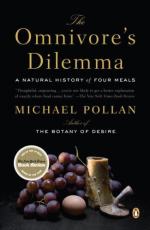
|
| Name: _________________________ | Period: ___________________ |
This test consists of 15 multiple choice questions and 5 short answer questions.
Multiple Choice Questions
1. Pollan notes that the end meal was _______ for him, according to the book.
(a) Boring.
(b) Anticlimactic.
(c) Difficult.
(d) Perfect.
2. The early researcher notes that _______ can be the result of situations that remind humans of their animal nature.
(a) Annoyance.
(b) Disgust.
(c) Happiness.
(d) Pleasure.
3. __________ involves higher emotions of dread, shame, and fear, according to Pollan.
(a) Society.
(b) Consequence.
(c) Moral drama.
(d) Suffering.
4. What do Pollan and Garro decide to go out to hunt at the start of the chapter?
(a) Wild boar.
(b) Squirrel.
(c) Deer.
(d) Bears.
5. A new economy, based on a new way of __________, demands a new kind of eating where people enjoy preparing meals.
(a) Shopping.
(b) Farming.
(c) Buying.
(d) Delivering.
6. What does Pollan not have ready when he is about to take down a boar, causing him to feel ashamed?
(a) Hat.
(b) Stance.
(c) Gun.
(d) Hand position.
7. Buying local foods grown in a __________ manner underwrites a set of values important to the people.
(a) Organic.
(b) Sustainable.
(c) Industrial.
(d) Plentiful.
8. Pollan wants to create a meal in full ________ of the foods involved and how they came to be on his table.
(a) Consciousness.
(b) Transparency.
(c) Truth.
(d) Beauty.
9. Pollan wants to say ________ to the animals for the meal, but realizes this is already in the meal.
(a) Thanks.
(b) Nothing.
(c) Grace.
(d) Prayers.
10. Bev sells to _______ worried about their children, and for those choosing to opt out of the industrial system.
(a) Young brothers.
(b) Young fathers.
(c) Priests.
(d) Young mothers.
11. Pollan notes that one of the lessons of hunting for food is _________, and of the relationships between man and food.
(a) Understanding.
(b) Power.
(c) Ethics.
(d) Peace.
12. _________ changed the way that humans ate, and put humans at the top of the food chain.
(a) Gathering.
(b) Stores.
(c) Hunting.
(d) Cooking.
13. Garro brings a ________ from the boar that Pollan killed on his hunting trip.
(a) Pate.
(b) Sausage.
(c) Pulled pork sandwich.
(d) Porkchop.
14. The alliance between chefs and small farmers is what helps _____________ flourish.
(a) Grocery stores.
(b) Schools.
(c) Cooking schools.
(d) Local economies.
15. What does Pollan need to prepare for that allows him to become more aware of his natural surroundings?
(a) His book's deadline.
(b) Hunting license.
(c) First meal.
(d) Final meal.
Short Answer Questions
1. Pollan notes that the last meal serves as a reminder of the fact that eating industrially lets people _________ the massive total cost of the food they eat.
2. Pollan and the guests at the dinner achieve the pleasures of the ________, a camaraderie during the meal.
3. The tart is made with _________ from Pollan's neighbor's garden as a dessert.
4. Pollan makes __________ toasts from the produce in his garden and bread that uses yeast he has gathered.
5. Pollan admits that losing ________ does force the human to lose a part of his or her culture as well as his or her nature.
|
This section contains 445 words (approx. 2 pages at 300 words per page) |

|




